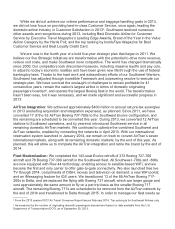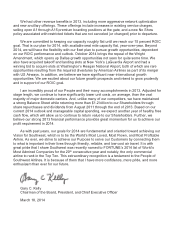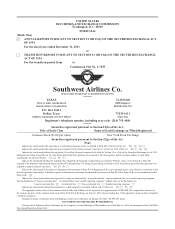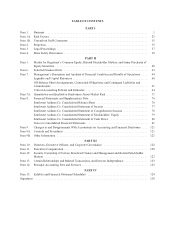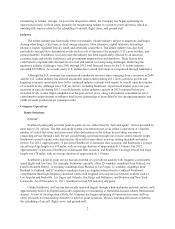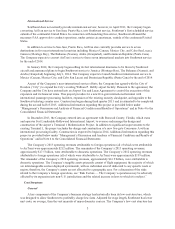Southwest Airlines 2013 Annual Report Download - page 12
Download and view the complete annual report
Please find page 12 of the 2013 Southwest Airlines annual report below. You can navigate through the pages in the report by either clicking on the pages listed below, or by using the keyword search tool below to find specific information within the annual report.
historically been facilitated by Southwest’s use of a single aircraft type, the Boeing 737, an operationally
efficient point-to-point route structure, and highly productive Employees. Southwest’s use of a single aircraft
type has allowed for simplified scheduling, maintenance, flight operations, and training activities. Southwest’s
point-to-point route structure includes service to and from many secondary or downtown airports such as Dallas
Love Field, Houston Hobby, Chicago Midway, Baltimore-Washington International, Burbank, Manchester,
Oakland, San Jose, Providence, and Ft. Lauderdale-Hollywood. These conveniently located airports are typically
less congested than other airlines’ hub airports, which has enabled Southwest to achieve high asset utilization
because aircraft can be scheduled to minimize the amount of time they are on the ground. This, in turn, has
reduced the number of aircraft and gate facilities that would otherwise be required and allows for high Employee
productivity (headcount per aircraft).
The Company believes that its fleet modernization initiatives, as well as the continued addition of the
larger Boeing 737-800 to the Southwest fleet, will have a favorable impact on the Company’s unit costs. These
strategic initiatives are discussed in more detail below under “Operating Strategies and Initiatives — Fleet
Modernization” and “Operating Strategies and Initiatives — Continued Incorporation of the Larger Boeing 737-
800 into the Southwest Fleet.”
Impact of Fuel Costs on the Company’s Low-Cost Structure
In 2013, the Company again experienced significant Fuel and oil expense as fuel prices, although lower
than levels reached in 2012, remained at high levels. In addition, for the ninth consecutive year, Fuel and oil
expense represented the Company’s largest or second largest cost and was the Company’s largest cost for the
third consecutive year. The table below shows the Company’s average cost of jet fuel and oil over the past eleven
years and during each quarter of 2013.
Year
Cost
(Millions)
Average
Cost Per
Gallon
Percentage of
Operating
Expenses
2003 ........................................ $ 920 $ 0.80 16.5%
2004 ........................................ $ 1,106 $ 0.92 18.1%
2005 ........................................ $ 1,470 $ 1.13 21.4%
2006 ........................................ $ 2,284 $ 1.64 28.0%
2007 ........................................ $ 2,690 $ 1.80 29.7%
2008 ........................................ $ 3,713 $ 2.44 35.1%
2009 ........................................ $ 3,044 $ 2.12 30.2%
2010 ........................................ $ 3,620 $ 2.51 32.6%
2011 ........................................ $ 5,644 $ 3.19 37.7%
2012 ........................................ $ 6,120 $ 3.30 37.2%
2013 ........................................ $ 5,763 $ 3.16 35.1%
First Quarter 2013 ............................. $ 1,457 $ 3.36 36.3%
Second Quarter 2013 ........................... $ 1,489 $ 3.11 35.4%
Third Quarter 2013 ............................ $ 1,450 $ 3.10 34.9%
Fourth Quarter 2013 ........................... $ 1,367 $ 3.08 33.8%
The Company enters into fuel derivative contracts to manage its risk associated with significant increases
in fuel prices; however, because energy prices can fluctuate significantly in a relatively short amount of time, the
Company must also continually monitor and adjust its fuel hedge portfolio and strategies to address not only fuel
price increases, but also fuel price volatility and hedge collateral requirements. Although jet fuel prices were less
volatile in 2013 than in some previous years, they remain at high levels and continue to be subject to extreme
volatility based on a variety of factors. In addition, the cost of hedging has increased in recent years with current
sustained high jet fuel prices and the potential for volatility in the fuel market. The Company’s fuel hedging
activities are discussed in more detail below under “Risk Factors,” “Management’s Discussion and Analysis of
Financial Condition and Results of Operations,” and Note 10 to the Consolidated Financial Statements.
4


